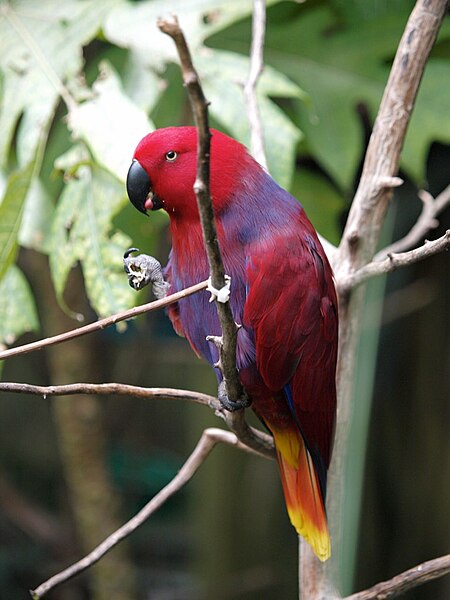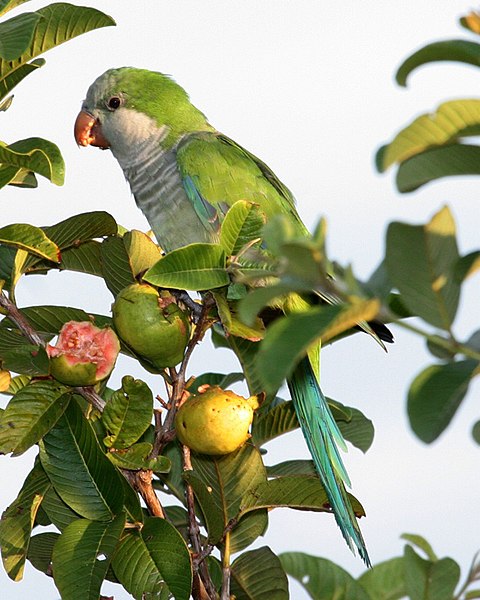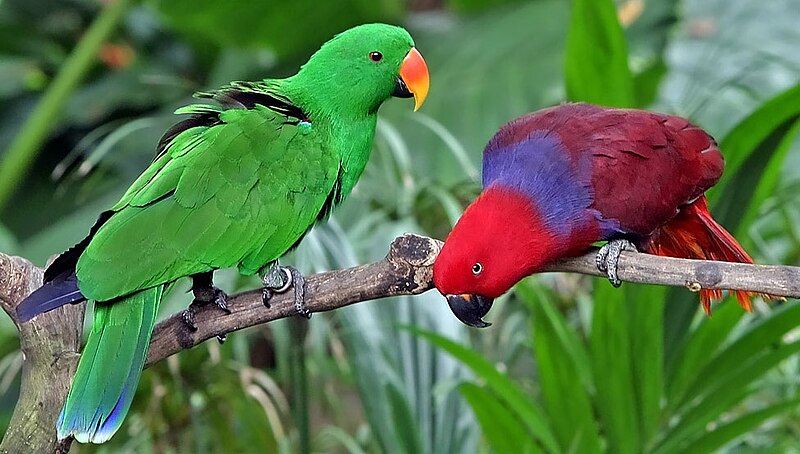Recently, a bird owner confided to me that, although pets were prohibited in her tiny Manhattan apartment, she was able to keep an English budgerigar because it was very quiet and also a good deal less active than the American budgies which she had kept. Thinking back, I realized that English budgerigars, which are actually the same species – Melopsittacus undulatus – as the “parakeet” typically sold in American pet stores, have also impressed me as being somewhat reserved in nature. Perhaps they are ideal for those of you who need to keep birds surreptitiously?
Appearance and Exhibition Standards
 English Budgerigars, or budgies, are sometimes referred to as “show or exhibition budgerigars”. They are stouter than the “American Budgerigar”, which is also known by the common name of “parakeet”. Both are larger than wild budgerigars – twice as large in the case of the English race.
English Budgerigars, or budgies, are sometimes referred to as “show or exhibition budgerigars”. They are stouter than the “American Budgerigar”, which is also known by the common name of “parakeet”. Both are larger than wild budgerigars – twice as large in the case of the English race.
English Budgerigars have long been bred as show birds, with strict standards governing their colors, plumage type, and body plan. Their faces and breasts are more thickly feathered than the typical American Budgie…some individuals sport feathers that nearly obscure the eyes and beak. The actual size of the head, in relation to the body, is also greater than in the American race.
Over thirty primary, and hundreds of secondary, color mutations are recognized, with individual colors often being brighter and somehow more clearly defined than those of their American counterparts.
Personality and Vocabulary
Behavior varies greatly from bird to bird, but overall English budgies are quite calm in nature, with even parent-raised individuals being relatively easy to tame.
Many, but not all, are also on the quiet side, but they retain wonderful mimicry abilities. Like American Budgies, English birds can amass huge vocabularies, a skill that is sometimes not fully appreciated due to their low, subdued voices. However, aviculturists rank budgerigars alongside African Grays, Amazons, Eclectus Parrots and other gifted mimics. In fact, a budgerigar holds the record for the largest bird vocabulary known – over 1,700 words!
Keeping English Budgies
In common with all parrots, English Budgies do best in pairs or well-planned groups. All-male groups, or several pairs, often work out well, but females can be quite vicious towards one another. English Budgerigars have the reputation of being somewhat short lived – 7 to 10 years as opposed to the American Budgerigar’s lifespan of 12 to nearly 20 years – but there have been notable exceptions.
English Budgerigars are not all that common in the USA, and will more usually be available through private breeders as opposed to pet stores. However, the search is well worthwhile – their plumage imparts a very comical look to the face (some find them to resemble minute old men!), and, if noise and space is a concern, they may well be the best parrot option available.
Further Reading
Please see my article The Captive Care and Natural History of Budgerigars for further information.
The Great Lakes Budgie Society posts English Budgie show standards and results here.
Budgerigar Head Detail image referenced from wikipedia and originally posted by Kirk
 That Bird Blog – Bird Care and History for Pet Birds
That Bird Blog – Bird Care and History for Pet Birds

 upon the species, pigeons and doves should be provided with pellets, whole wheat bread, chopped kale and other greens and fruit.
upon the species, pigeons and doves should be provided with pellets, whole wheat bread, chopped kale and other greens and fruit.  Europeans to encounter them in Indonesia. Indeed, few bird species, and no other parrots, exhibit such extreme sexual dimorphism.
Europeans to encounter them in Indonesia. Indeed, few bird species, and no other parrots, exhibit such extreme sexual dimorphism. Various theories have been proposed to explain the Eclectus’ surprising sexual dimorphism. One relates the phenomenon to the differing life styles of the sexes. During the breeding season, females spend the majority of their days in and near the nesting hole. In their leaf-covered, dimly lit nesting areas, located high in the forest canopy, the deep reds and blues of their feathers blend in well with the shadows falling upon the bark, limbs and leaves.
Various theories have been proposed to explain the Eclectus’ surprising sexual dimorphism. One relates the phenomenon to the differing life styles of the sexes. During the breeding season, females spend the majority of their days in and near the nesting hole. In their leaf-covered, dimly lit nesting areas, located high in the forest canopy, the deep reds and blues of their feathers blend in well with the shadows falling upon the bark, limbs and leaves. keeping our avian friends occupied. Among the most useful are those that, provisioned with food, encourage birds to work at obtaining snacks. Known as “
keeping our avian friends occupied. Among the most useful are those that, provisioned with food, encourage birds to work at obtaining snacks. Known as “ Live insects are unbeatable in arousing the interest of finches, white-eyes and most softbills. By allowing mealworms or waxworms to burrow into a pan of sand or oatmeal, you can keep you pets happily hunting for hours. Crickets are even better, especially if you stock the cage bottom with empty paper towel rolls in which the insects can hide. Plastic wrap wound around the lower 2 inches of the cage bars will help contain any crickets that escape your pet’s notice.
Live insects are unbeatable in arousing the interest of finches, white-eyes and most softbills. By allowing mealworms or waxworms to burrow into a pan of sand or oatmeal, you can keep you pets happily hunting for hours. Crickets are even better, especially if you stock the cage bottom with empty paper towel rolls in which the insects can hide. Plastic wrap wound around the lower 2 inches of the cage bars will help contain any crickets that escape your pet’s notice. Many consider the eclectus to be the most beautiful of all parrots. In fact, early in their avicultural history folks rarely tried to teach eclectus to speak…surely such a gorgeous bird could not also be a talented mimic.
Many consider the eclectus to be the most beautiful of all parrots. In fact, early in their avicultural history folks rarely tried to teach eclectus to speak…surely such a gorgeous bird could not also be a talented mimic.